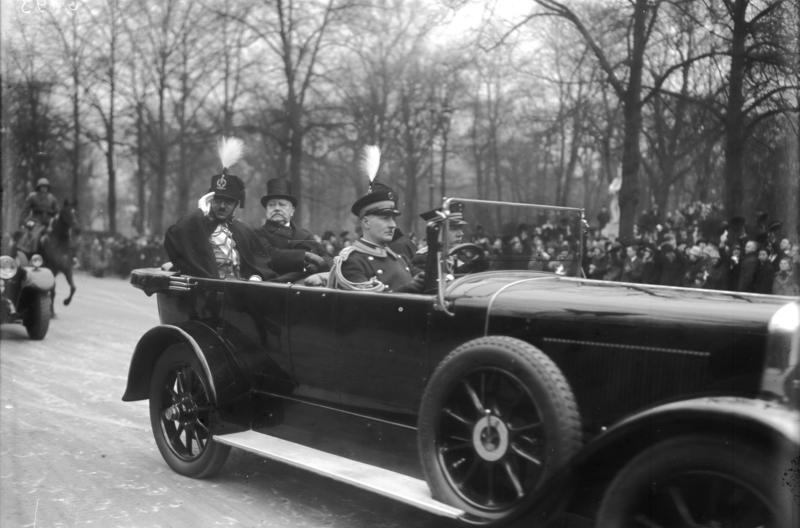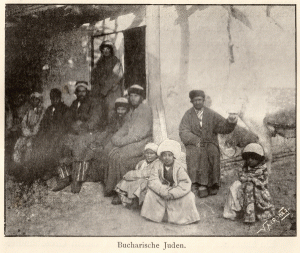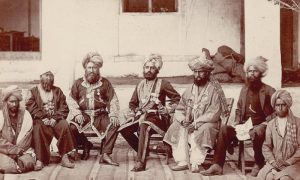The Second Tournament of Shadows and British Invasion Scares in Central Asia, 1919–1933
During the 19th century, Britain and Russia vied for influence in the territories between British India in the south and the Russian-controlled Kazakh steppe to the north. In Britain and the West, this conflict is most commonly known as the Great Game, in Russia, perhaps more adequately as the Tournament of Shadows. Both powers ended their struggle for influence with the Anglo-Russian Entente of 1907. Both states divided all territories from Tibet in the east up to the Persian-Ottoman border in the west into respective spheres of influence. Nevertheless, tensions remained until Germany plunged Europe into war in 1914. After the First World War, the October Revolution in 1917, the Third Anglo-Afghan War of 1919 and the failure of the Anglo-Persian Agreement that same year, international policy toward Central Asia had changed dramatically.
Beginning in 1919, a Second Tournament of Shadows commenced. Afghanistan, Persia and Xinjiang (the latter a then de facto independent region governed by warlord administrators) pursued policies independent of London and Moscow, while in Bukhara and Khiva, Mongolia and Tannu-Tuva (a small statelet now within the Russian Federation), modernists established states under the umbrella of Soviet protection. The Soviets had previously intervened militarily in some of those regions, but had withdrawn from Persia and Xinjiang by mid-1920. From then on, the Soviets sought to alter the economic and political situation in Afghanistan, Persia and Xinjiang largely without military means. Though Soviet forces would return to the latter in 1934.
The Germans, an additional player in this Second Tournament of Shadows, returned soon after their defeat in the First World War, establishing relations with Afghanistan in 1921. After the settlement of all post-war issues – especially the outstanding German-Soviet economic questions – in the Treaty of Rapallo, the Weimar Republic appeared as Soviet Central Asia’s door to the world market and the Germans established contacts with Bukhara, Khiva, and Mongolia via their respective embassies in Moscow.[1] Bukhara even sent an official trade delegation to Berlin in 1922.[2]
For the British, prospects in the early 1920s seemed bleak. Afghanistan had re-gained independence and established close relations with Germany and Soviet Russia. In Persia, expansionist British foreign minister Lord Curzon failed in his project to turn the country into a protectorate and with Reza Shah’s coup in 1921, the country followed a course of modernization similar to Kemalist Turkey. Consequently, the British feared that Afghanistan, Bukhara, Khiva, Persia, Soviet Russia and Turkey could establish an “Eastern Entente” in 1922.[3] This scenario did not materialize due to frictions between those countries. Also in 1922, the British established a legation in Kabul and thus gained exclusive access to the Afghan Royal Court. Even though bilateral relations remained difficult, the legation enhanced British understanding of Afghan foreign policy and Central Asian affairs.
The failure of the “Eastern Entente” and the establishment of a permanent British mission in Kabul brought the Second Tournament of Shadows into full swing. Germany, Great Britain and the newly established Soviet Union tried to influence economic, political and military affairs in the wider Central Asian regions to their own benefit. Soviet Central Asian territories, including the two nominally independent states of Bukhara and Khiva, were excluded from this game after Joseph Stalin, then the People’s Commissar for Nationalities, developed a detailed plan to curtail foreign influence.[4] Both People’s Soviet Republics merged to become the Uzbek Soviet Socialist Republic in 1924. This narrowed the conflict geographically down to Persia, Afghanistan, Xinjiang and Mongolia – a vast territory on the edge of British Indian, Chinese, Japanese and Soviet zones of influence.
During the entire period, British perceptions of this region were continuously clouded by invasion scares – as in the decades before. British officials continuously described the alleged plans of Soviet invasions either via Afghanistan, Persia, or Xinjiang into British India.[5] The British associated every form of internal unrest with Soviet influence in the region. In their perception of the region, the British always focused on the heads of states of the region and did not consider that the political scene of the region might change due to economic and other internal factors. The continued imperial paranoia often led to simplified and mostly incorrect conclusions.
In their constant fixation on the Soviets, the British could not grasp local developments like modernization efforts. For example, when the Afghan king established the Afghan Air Force in 1924 and accepted a Soviet offer of planes and pilots, London’s Air Ministry opened a file about the “Russo-Afghan Menace.”[6] Representatives of the Air Ministry, Foreign Office, India Office and War Office discussed what they perceived as Moscow’s “advanced base.”[7] They did not discuss the Afghan aims, seeing the locals as mere Soviet pawns.
Interestingly, the British invasion scares did not lead London to behave aggressively in Central Asia. On the contrary, the UK officials turned to pen-pushing. His Majesty’s officials constantly produced memoranda with imagined lines in the sands the Soviets should not cross. While Moscow and other players in the region were often not informed of those red lines, the Bolsheviks crossed the imaged lines or events on the ground changed the circumstances – while the British did mostly nothing.
While the British always identified the Soviets as their arch-enemies in Central Asia (and the Soviets identified the British in turn), London’s perception of the Germans changed over the course of the 1920s. In the beginning, the Germans often appeared as a secret Soviet ally. British diplomats and officers associated them often with fantastic endeavors,[8] which turned out to be unsubstantiated rumors. Beginning in the mid-1920s, the depiction of the Weimar Republic’s role in Central Asia changed. While discussing their own plane delivery to Afghanistan, British officials considered the Germans, then the only persons capable of flying the planes, as the lesser evil to the Soviets.[9] The Germans themselves considered the region to be beyond London’s and Moscow’s reach and formulated its first Central Asia strategy in 1926. The strategy outlined a desire for German companies to be involved in economic projects in Afghanistan, Mongolia, Persia, and Xinjiang and also made credits available for those companies.[10]
The Second Tournament of Shadows ended with the civil wars in Afghanistan (1929) and Xinjiang (1933/1934). The former dethroned the modernist Afghan King Amanullah. He was eventually succeeded by the conservative Nadir Khan, who minimized ties with the USSR. In Moscow, the party leadership decided that it was futile to export further weapons to Afghanistan.[11] The latter civil war grew out of a rebellion against the anti-Muslim politics of governor Jin Shuren and plunged the province into chaos. Prior to this, Jin had tried to escape the continuous Anglo-Soviet struggle for influence in his province by fostering close relations with Germany. He sent a representative to Berlin, Burhan Shahidi, who later became famous for being the last Kuomintang governor of Xinjiang, and several German companies exported important machinery to Xinjiang and planes from the German-Chinese Eurasia aviation company landed with German products in the province for the first time in 1931.[12] Faced with the possibility of a Japanese puppet state in Xinjiang[13], Moscow decided to intervene.[14] In early 1934, the Red Army invaded the Chinese province and propped up a new governor, Sheng Xicai. About the same time, the Soviets cut off German transit routes to Xinjiang.
The Second Tournament of Shadows ended with Mongolia, Soviet Central Asia, Tannu-Tuva and Xinjiang isolated from non-Soviet influence. In Afghanistan and Persia, conservative governments ruled with stable relations with Germany and Great Britain and minimal contacts with the Soviets. Unlike 1907, the partition of Central Asia into zones of influence happened without a formal agreement between Moscow and London.
David X. Noack is a doctoral candidate at the Mannheim University. His research focuses on Eastern Europe and Central Asia in the twentieth century. Follow him on Twitter @davidnoack.
Notes
[1] Political Archive of the Foreign Ministry (Berlin, Germany, henceforth: PA-AA): R84342: K. Wiedenfeld to Auswärtiges Amt, Moscow, 10.07.1922.
[2] PA-AA: R84342: W. Waßmuß: Aufzeichnung, [Berlin], 07.12.1922.
[3] The National Archives (Kew, United Kingdom, henceforth: TNA): FO: 371/8073: Secret Intelligence Service to Foreign Office: Alleged plan for “Eastern Entente”, [London], 23.03.1922.
[4] Russian State Archive of Socio-Political History (Moscow, Russia, henceforth: RGASPI): Fond 17, Opis 3, Dela 293: ACP (b) CC: Protocol No. 7, Moscow, 26.05.1922.
[5] For example: TNA: FO: 371/5416: S. Tallents to Foreign Office: Soviet Army in Training at Tashkent (Highly Secret), Riga, 06.10.1920; TNA: FO: 371/5383: W. Malleson to Chief of the General Staff (Simla): Telegram P., No. M. D. 03707, Meshed, 22.04.1920; TNA: FO: 371/5383: W. Malleson to Chief of the General Staff (Simla): Telegram P., No. M. D. 03681, Meshed, 15.04.1920.
[6] TNA: AIR: 5/608, Part 1.
[7] TNA: FO: 371/10984: India Office to Foreign Office: Russians in Afghanistan, [London], 09.10.1925.
[8] TNA: FO: 371/5382: India Office to Foreign Office: Situation in Central Asia, [London], 05.11.1920; TNA: FO: 371/6851: Ernest Rennie to Foreign Office: Conditions in Petrograd and growth of German influence in Russia, Helsingfors, 19.09.1921; TNA: FO: 371/7835: Percy Loraine to Foreign Office: German Commercial Enterprise in Persia, Teheran, 08.07.1922.
[9] TNA: FO: 371/10984: India Office to Foreign Office: Russians in Afghanistan, [London], 09.10.1925.
[10] Akten zur Deutschen Auswärtigen Politik (Documents on German Foreign Policy), Series B: 1925–1933, Volume II, 1, No. 61: G. Stresemann and J. Curtius to F. Kempner, Berlin, 12.02.1926.
[11] RGASPI: Fond 17, Opis 162, Dela 9: ACP (b) CC: Protocol No. 10, Moscow, 25.09.1930.
[12] General Archive of the Societas Verbi Divini (Rome, Italy): 633: Sinkiang: W. Gier to G. Hilbrenner, [Rome], 02.03.1932.
[13] India Office Records (London, United Kingdom): L/P&J/12/125: Far Eastern Department (Foreign Office) to Mr. Norton, India Office and War Office (M.I.l.c.): Alleged Japanese intrigues in regard to Sinkiang, [London], 11.12.1933.
[14] RGASPI: Fond 17, Opis 162, Dela 15, L. 23: ACP (b) CC: Protocol No. 143, Moscow, 15.08.1933.




